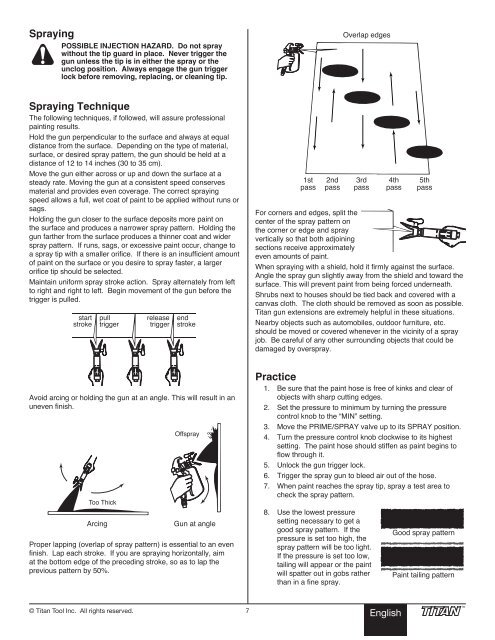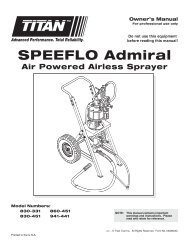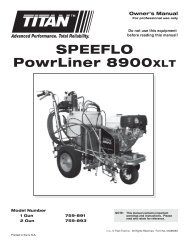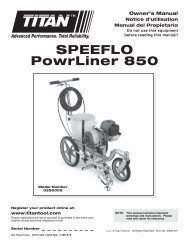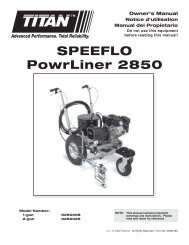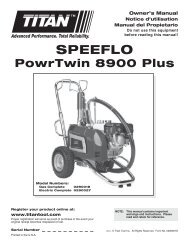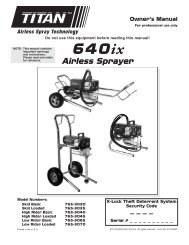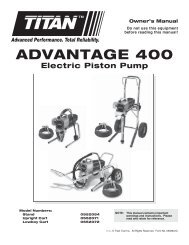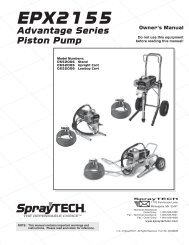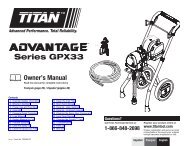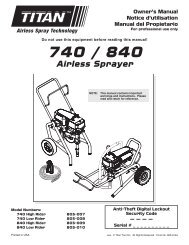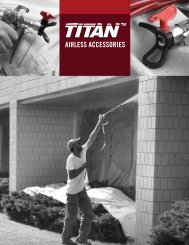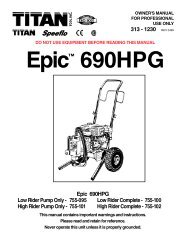You also want an ePaper? Increase the reach of your titles
YUMPU automatically turns print PDFs into web optimized ePapers that Google loves.
Spraying<br />
POSSIBLE INJECTION HAZARD. Do not spray<br />
without the tip guard in place. Never trigger the<br />
gun unless the tip is in either the spray or the<br />
unclog position. Always engage the gun trigger<br />
lock before removing, replacing, or cleaning tip.<br />
Overlap edges<br />
Spraying Technique<br />
The following techniques, if followed, will assure professional<br />
painting results.<br />
Hold the gun perpendicular to the surface and always at equal<br />
distance from the surface. Depending on the type of material,<br />
surface, or desired spray pattern, the gun should be held at a<br />
distance of 12 to 14 inches (30 to 35 cm).<br />
Move the gun either across or up and down the surface at a<br />
steady rate. Moving the gun at a consistent speed conserves<br />
material and provides even coverage. The correct spraying<br />
speed allows a full, wet coat of paint to be applied without runs or<br />
sags.<br />
Holding the gun closer to the surface deposits more paint on<br />
the surface and produces a narrower spray pattern. Holding the<br />
gun farther from the surface produces a thinner coat and wider<br />
spray pattern. If runs, sags, or excessive paint occur, change to<br />
a spray tip with a smaller orifice. If there is an insufficient amount<br />
of paint on the surface or you desire to spray faster, a larger<br />
orifice tip should be selected.<br />
Maintain uniform spray stroke action. Spray alternately from left<br />
to right and right to left. Begin movement of the gun before the<br />
trigger is pulled.<br />
start<br />
stroke<br />
pull<br />
trigger<br />
release<br />
trigger<br />
end<br />
stroke<br />
1st<br />
pass<br />
2nd<br />
pass<br />
3rd<br />
pass<br />
4th<br />
pass<br />
5th<br />
pass<br />
For corners and edges, split the<br />
center of the spray pattern on<br />
the corner or edge and spray<br />
vertically so that both adjoining<br />
sections receive approximately<br />
even amounts of paint.<br />
When spraying with a shield, hold it firmly against the surface.<br />
Angle the spray gun slightly away from the shield and toward the<br />
surface. This will prevent paint from being forced underneath.<br />
Shrubs next to houses should be tied back and covered with a<br />
canvas cloth. The cloth should be removed as soon as possible.<br />
Titan gun extensions are extremely helpful in these situations.<br />
Nearby objects such as automobiles, outdoor furniture, etc.<br />
should be moved or covered whenever in the vicinity of a spray<br />
job. Be careful of any other surrounding objects that could be<br />
damaged by overspray.<br />
Avoid arcing or holding the gun at an angle. This will result in an<br />
uneven finish.<br />
Too Thick<br />
Arcing<br />
Offspray<br />
Gun at angle<br />
Proper lapping (overlap of spray pattern) is essential to an even<br />
finish. Lap each stroke. If you are spraying horizontally, aim<br />
at the bottom edge of the preceding stroke, so as to lap the<br />
previous pattern by 50%.<br />
Practice<br />
1. Be sure that the paint hose is free of kinks and clear of<br />
objects with sharp cutting edges.<br />
2. Set the pressure to minimum by turning the pressure<br />
control knob to the “MIN” setting.<br />
3. Move the PRIME/SPRAY valve up to its SPRAY position.<br />
4. Turn the pressure control knob clockwise to its highest<br />
setting. The paint hose should stiffen as paint begins to<br />
flow through it.<br />
5. Unlock the gun trigger lock.<br />
6. Trigger the spray gun to bleed air out of the hose.<br />
7. When paint reaches the spray tip, spray a test area to<br />
check the spray pattern.<br />
8. Use the lowest pressure<br />
setting necessary to get a<br />
good spray pattern. If the<br />
pressure is set too high, the<br />
spray pattern will be too light.<br />
If the pressure is set too low,<br />
tailing will appear or the paint<br />
will spatter out in gobs rather<br />
than in a fine spray.<br />
Good spray pattern<br />
Paint tailing pattern<br />
© Titan Tool Inc. All rights reserved. 7<br />
English


